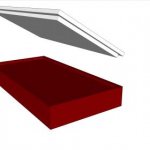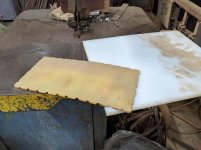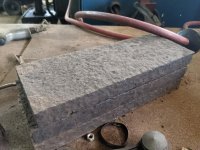JasonPAtkins
Hot Rolled
- Joined
- Sep 30, 2010
- Location
- Guinea-Bissau, West Africa
Hey all, I operate a compressed adobe block making machine over here, which I'm currently using to build my new shop.
This is the machine: Advanced Earthen Construction Technologies - Construction Equipment
Here are a couple of clips of the cycle, and a few pics: Shared album - Jason Atkins - Google Photos
It's a really cool technology, but the machine is getting a bit old and I have a failure in a part I don't have a backup for.
The machine forms adobe blocks at about 2000 psi, by pressing a 6"x12" piece of 1.5" plate up against another piece of plate.
That plate has a 1/4" deep recess in its 6"x12" face, which from the factory was filled with some kind of polymer that's baked in place, which serves as a release agent, because the machine presses the plate up to form the block, backs off half an inch while the carriage returns, and then pushes the block up out of the forming cavity. The factory said that when they used plain steel plate, before they tried that polymer, the suction between the block and the plate was ripping the blocks in half on that little half inch retract. (The material it's pressing is just slightly damp to the touch, it's not wet.)
Unfortunately, today the polymer let go of the plate. The factory says they don't have any success rebonding it, and is offering a new plate. That's great, but I don't have a way to get it here in a timeframe that's soon enough.
So, I'm considering a UHMW part as a bandaid.

Basically just a piece of 1/2" thick UHMW sheet, with a little inset cut into the bottom side to fill the void in the plate where the polymer was. I'll tap the plate and screw the UHMW down with countersunk hex head screws. This solution will end up being 1/4" taller than the previous solution, but I can adjust that out of the machine movement.
So, what say you about UHMW suitability for this? First, is it strong enough in compression? My suspicion is yes. Worst case I can imagine is that over time the UHMW gets compressed a little shorter, and I can adjust the machine accordingly. The larger question is the adhesion problem. UHMW is slick in terms of material sliding over its face, but that's not the motion in question here. With a slightly damp clay material compressed over the face of the UHMW, how well do you think it lets go of the clay? Or does the fact that the face of the UHMW sheet is so smooth mean it vacuums itself to the bottom of the block and adheres to it so well that when the plate retracts away, it rips the block in half on the retraction cycle?
This is the machine: Advanced Earthen Construction Technologies - Construction Equipment
Here are a couple of clips of the cycle, and a few pics: Shared album - Jason Atkins - Google Photos
It's a really cool technology, but the machine is getting a bit old and I have a failure in a part I don't have a backup for.
The machine forms adobe blocks at about 2000 psi, by pressing a 6"x12" piece of 1.5" plate up against another piece of plate.
That plate has a 1/4" deep recess in its 6"x12" face, which from the factory was filled with some kind of polymer that's baked in place, which serves as a release agent, because the machine presses the plate up to form the block, backs off half an inch while the carriage returns, and then pushes the block up out of the forming cavity. The factory said that when they used plain steel plate, before they tried that polymer, the suction between the block and the plate was ripping the blocks in half on that little half inch retract. (The material it's pressing is just slightly damp to the touch, it's not wet.)
Unfortunately, today the polymer let go of the plate. The factory says they don't have any success rebonding it, and is offering a new plate. That's great, but I don't have a way to get it here in a timeframe that's soon enough.
So, I'm considering a UHMW part as a bandaid.

Basically just a piece of 1/2" thick UHMW sheet, with a little inset cut into the bottom side to fill the void in the plate where the polymer was. I'll tap the plate and screw the UHMW down with countersunk hex head screws. This solution will end up being 1/4" taller than the previous solution, but I can adjust that out of the machine movement.
So, what say you about UHMW suitability for this? First, is it strong enough in compression? My suspicion is yes. Worst case I can imagine is that over time the UHMW gets compressed a little shorter, and I can adjust the machine accordingly. The larger question is the adhesion problem. UHMW is slick in terms of material sliding over its face, but that's not the motion in question here. With a slightly damp clay material compressed over the face of the UHMW, how well do you think it lets go of the clay? Or does the fact that the face of the UHMW sheet is so smooth mean it vacuums itself to the bottom of the block and adheres to it so well that when the plate retracts away, it rips the block in half on the retraction cycle?



